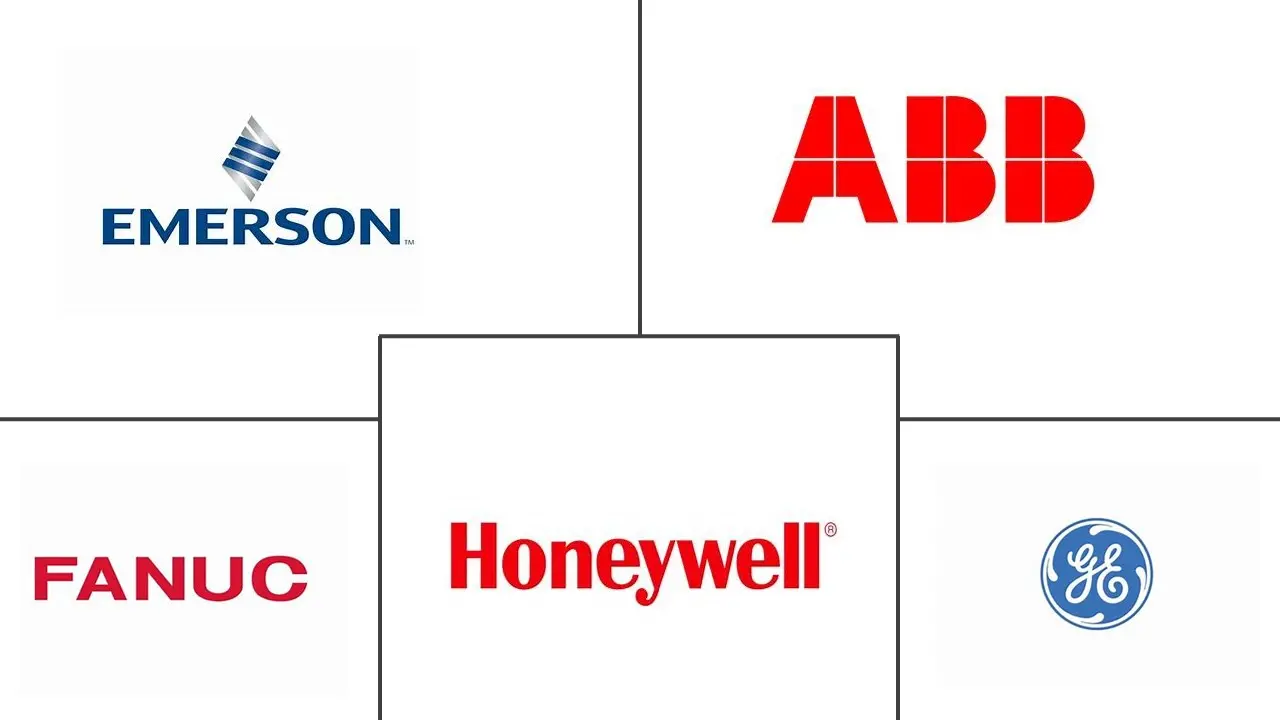Market Size of Smart Manufacturing Industry

| Study Period | 2019 - 2029 |
| Market Size (2024) | USD 141.39 Billion |
| Market Size (2029) | USD 279.23 Billion |
| CAGR (2024 - 2029) | 14.58 % |
| Fastest Growing Market | Asia Pacific |
| Largest Market | North America |
Major Players
*Disclaimer: Major Players sorted in no particular order |
Smart Manufacturing Market Analysis
The Smart Manufacturing Market size is estimated at USD 141.39 billion in 2024, and is expected to reach USD 279.23 billion by 2029, growing at a CAGR of 14.58% during the forecast period (2024-2029).
The increasing initiatives to adopt smart manufacturing will drive market growth. Smart Manufacturing Leadership Coalition (SMLC), a combination of US-based industrial organizations, technology suppliers, laboratories, and universities, is working on a next-generation Smart Manufacturing Platform and Smart Factory connectivity. Similarly, another industry-led initiative, the Industrial Internet Consortium (IIC), was formed to bring together the advanced technologies and organizations needed to accelerate the growth of industrial automation.
Using services and software, such as SCADA, ERP, HMI, PLC, DCS, PLM, and MES, has enabled industries to collect real-time data and make decisions. The software has been beneficial to the industry as it reduces product errors, reduces downtime, conducts planned maintenance, moves from the reactive phase to the predictive and prescribing phases, and enables decision-making.
The dependence on process control and systems combined with the convergence of IT and operating technologies systems has increasingly exposed manufacturing firms to cyber attacks. Manufacturers' control systems have long been deemed impenetrable due to their proprietary and customized networks. IoT has opened the scope for the theft of proprietary information. With more automation and digitization of these devices, which were originally built without the proper security measures, the data security concern will also grow, hindering the market growth.
Furthermore, investments in Industry 4.0 are rising globally. Organizations have started adopting Industry 4.0 smart solutions owing to their positive impact on their businesses, including increased productivity. For instance, as per a report by Capgemini and the National Association of Software and Services Companies (NASSCOM), it is expected that more than two-thirds of the Indian manufacturing sector intention embrace Industry 4.0. by 2025
Moreover, the companies operating in the market focus on innovations and launch new products to stay ahead of the competition. For instance, in February 2023, which announced the launch of Programmable Logic Controller OTAC to combat key unresolved challenges related to industrial IoT, smart factories, and operational technology (OT). This provides a highly optimized and highly secure authentication solution specifically for PLC devices by utilizing their dynamic 'one-time authentication code' (OTAC) technology to resolve typical ICS/OT security challenges.
The outbreak of COVID-19 triggered the manufacturing sector to re-evaluate its traditional production processes, primarily driving digital transformation and smart manufacturing practices across the production lines. The manufacturers also forced to implement and devise multiple agile and new approaches to monitor product and quality control.
Smart Manufacturing Industry Segmentation
Smart manufacturing utilizes Big Data analytics to refine complicated processes and manage supply chains. Big data analytics allows an enterprise to use smart manufacturing to shift from reactionary practices to predictive ones, a change that targets improved efficiency of the process and product performance.
The Global Smart Manufacturing Market is segmented by Technology (Programmable Logic Controller (PLC), Supervisory Controller and Data Acquisition (SCADA), Enterprise Resource and Planning (ERP), Distributed Control System (DCS), Human Machine Interface (HMI), Product Lifecycle Management (PLM), Manufacturing Execution System (MES)), Component (Machine Vision System, Control Devices, Robotics, Communication Segment, Sensor), End-user Industry (Automotive, Semiconductors, Oil and Gas, Chemical and Petrochemical, Pharmaceutical, Aerospace and Defense, Food and Beverage, Metals and Mining), and Geography(North America, Europe, Asia-Pacific, Middle east and Africa and Latin America). The report offers the market size in value terms in USD for all the above mentioned segments.
| By Technology | |
| Programmable Logic Controller (PLC) | |
| Supervisory Controller and Data Acquisition (SCADA) | |
| Enterprise Resource and Planning (ERP) | |
| Distributed Control System (DCS) | |
| Human Machine Interface (HMI) | |
| Product Lifecycle Management (PLM) | |
| Manufacturing Execution System (MES) | |
| Other Technologies |
| By Component | |
| Machine Vision Systems | |
| Control Device | |
| Robotics | |
| Communication Segment | |
| Sensor | |
| Other Components |
| By End-user Industry | |
| Automotive | |
| Semiconductors | |
| Oil and Gas | |
| Chemical and Petrochemical | |
| Pharmaceutical | |
| Aerospace and Defense | |
| Food and Beverage | |
| Metals and Mining | |
| Other End-user Industries |
| By Geography | ||||||
| ||||||
| ||||||
| ||||||
| ||||||
| Middle East and Africa |
Smart Manufacturing Market Size Summary
The smart manufacturing market is poised for significant growth, driven by the increasing adoption of advanced technologies and initiatives like the Smart Manufacturing Leadership Coalition and the Industrial Internet Consortium. These efforts aim to enhance connectivity and integration within smart factories, leveraging services and software such as SCADA, ERP, and IoT to optimize manufacturing processes. The convergence of IT and operational technologies has enabled real-time data collection and decision-making, reducing errors and downtime while shifting from reactive to predictive maintenance. However, the rise in automation and digitization has also heightened cybersecurity concerns, as traditional control systems become more vulnerable to cyber threats. Despite these challenges, the global push towards Industry 4.0 is fostering investments in smart manufacturing solutions, particularly in sectors like automotive, where smart technologies are enhancing productivity and efficiency.
Regions like Europe and Asia-Pacific are leading the charge in adopting smart manufacturing, with China and India making significant strides in digitalization and industrialization. China's transformation from labor-intensive to high-end manufacturing is a testament to the country's commitment to becoming a global leader in the Industrial Internet of Things (IIoT) market. Similarly, India's 'Make in India' initiative is driving the country's manufacturing sector towards greater automation and efficiency. Major industry players are investing in smart manufacturing capabilities to gain a competitive edge, with strategic collaborations and acquisitions further bolstering market growth. The competitive landscape is marked by significant investments in automation and robotics, with companies like Mitsubishi Electric and Honeywell International enhancing their product offerings to support factory optimization and automation.
Smart Manufacturing Market Size - Table of Contents
-
1. MARKET DYNAMICS
-
1.1 Market Drivers
-
1.1.1 Increasing Demand for Automation to Achieve Efficiency and Quality
-
1.1.2 Need for Compliance and Government Support for Digitization
-
1.1.3 Proliferation of Internet of Things
-
-
1.2 Market Restraints
-
1.2.1 Concerns Regarding Data Security
-
1.2.2 High Initial Installation Costs and Lack of Skilled Workforce Preventing Enterprises from Full-scale Adoption
-
-
-
2. MARKET SEGMENTATION
-
2.1 By Technology
-
2.1.1 Programmable Logic Controller (PLC)
-
2.1.2 Supervisory Controller and Data Acquisition (SCADA)
-
2.1.3 Enterprise Resource and Planning (ERP)
-
2.1.4 Distributed Control System (DCS)
-
2.1.5 Human Machine Interface (HMI)
-
2.1.6 Product Lifecycle Management (PLM)
-
2.1.7 Manufacturing Execution System (MES)
-
2.1.8 Other Technologies
-
-
2.2 By Component
-
2.2.1 Machine Vision Systems
-
2.2.2 Control Device
-
2.2.3 Robotics
-
2.2.4 Communication Segment
-
2.2.5 Sensor
-
2.2.6 Other Components
-
-
2.3 By End-user Industry
-
2.3.1 Automotive
-
2.3.2 Semiconductors
-
2.3.3 Oil and Gas
-
2.3.4 Chemical and Petrochemical
-
2.3.5 Pharmaceutical
-
2.3.6 Aerospace and Defense
-
2.3.7 Food and Beverage
-
2.3.8 Metals and Mining
-
2.3.9 Other End-user Industries
-
-
2.4 By Geography
-
2.4.1 North America
-
2.4.1.1 United States
-
2.4.1.2 Canada
-
-
2.4.2 Europe
-
2.4.2.1 Germany
-
2.4.2.2 United Kingdom
-
2.4.2.3 France
-
2.4.2.4 Rest of Europe
-
-
2.4.3 Asia Pacific
-
2.4.3.1 China
-
2.4.3.2 India
-
2.4.3.3 Japan
-
2.4.3.4 Rest of Asia Pacific
-
-
2.4.4 Latin America
-
2.4.4.1 Brazil
-
2.4.4.2 Mexico
-
2.4.4.3 Rest of Latin America
-
-
2.4.5 Middle East and Africa
-
-
Smart Manufacturing Market Size FAQs
How big is the Global Smart Manufacturing Market?
The Global Smart Manufacturing Market size is expected to reach USD 141.39 billion in 2024 and grow at a CAGR of 14.58% to reach USD 279.23 billion by 2029.
What is the current Global Smart Manufacturing Market size?
In 2024, the Global Smart Manufacturing Market size is expected to reach USD 141.39 billion.

